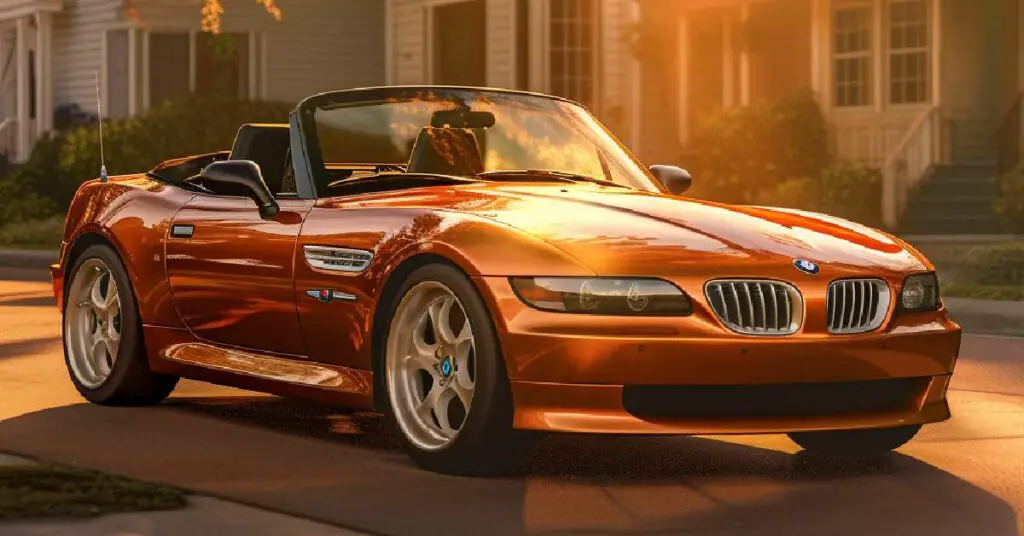
You’ve likely heard of the illustrious German automaker, BMW, known for its blend of luxury and performance, instilled into every vehicle they manufacture. But today, we’re not just talking about any BMW cars. Instead, we’re pitting two of their iconic roadsters against each other: the classic BMW Z3 and the contemporary BMW Z4.
In this head-to-head battle, we’ll delve into their history, design, performance, technology, and much more, ultimately helping you decide which of these formidable machines might be the right fit for your driveway. But let’s not jump ahead. First, let’s get acquainted with these two stunning vehicles and understand their place in BMW’s history.
Hang on to your steering wheel because this is not just any comparison. It’s a journey into the heart of BMW’s engineering prowess, an exploration of style and substance, speed and elegance. So whether you’re a die-hard car enthusiast or a potential buyer weighing your options, buckle up for an exciting ride. It’s the clash of the titans: BMW Z3 vs. Z4.
History and Evolution
The BMW Z3: The Birth of a Classic
In the realm of sports cars, the BMW Z3 stands as a symbol of a golden era. Introduced in 1995, this classic roadster made an instant impact, not just for its top-notch performance and handling, but also for its distinctive design that merged European flair with a hint of American muscle aesthetics.
Built in BMW’s Spartanburg plant in South Carolina, the Z3 was the first BMW model to be manufactured in the United States. It was unveiled to the world in the James Bond film, “GoldenEye,” instantly capturing the hearts of car enthusiasts and film fans alike.
As for its evolution, the Z3 received several upgrades throughout its lifetime. Initially, it was powered by a 1.9-liter four-cylinder engine, but later models came equipped with more potent six-cylinder engines. In 1997, the Z3 lineup expanded with the addition of the high-performance M Roadster and M Coupe, solidifying its status as a bona fide sports car.
Despite its production ending in 2002, the Z3 still holds a special place in the hearts of many, symbolizing an era of automotive design and engineering that’s still revered today.
The BMW Z4: A Step into the Modern Era
The successor to the Z3, the BMW Z4, was introduced in 2002 and was seen as a significant step forward in terms of design, technology, and performance. With its modern lines and aggressive stance, the Z4 embodied a new era for BMW roadsters.
Its initial model, the E85, featured a more streamlined and contemporary design than its predecessor. However, the most significant evolution was seen with the second generation, the E89, launched in 2009. It was equipped with a retractable hardtop, a first for BMW roadsters, blending the joy of open-top driving with the comfort and security of a coupe.
The latest generation, the G29, launched in 2018, stands as the epitome of BMW’s progression. It’s equipped with a host of cutting-edge technologies and a potent powertrain, underlining BMW’s commitment to performance, luxury, and driving pleasure.
Though younger than the Z3, the Z4 has undergone considerable evolution, consistently pushing the boundaries of what’s expected from a luxury roadster.
Design and Aesthetics
Exterior Design
From the first glance, it’s evident that the BMW Z3 and Z4 are two distinctively styled vehicles that cater to different aesthetic tastes.
The Z3, with its classical roadster silhouette, harks back to the era of vintage motoring. The long hood, rounded rear end, and the side gill design are nostalgic, reminiscent of classic sports cars. BMW also cleverly infused some American design influences, acknowledging its birthplace in South Carolina. This blend resulted in an exterior that’s both unique and widely loved, marking the Z3 as a timeless classic.
On the other hand, the Z4, especially in its latest generation, is all about modernity and futurism. It abandons the more traditional design cues of the Z3 in favor of bold lines, aggressive aerodynamics, and a more angular approach. The long hood remains, a nod to the roadster DNA, but the rest is unequivocally contemporary, down to the signature kidney grille which has become larger and more prominent. The result is a car that looks ready to slice through the wind and turns heads wherever it goes.
Interior Design
Moving inside, both cars continue their respective design philosophies.
The Z3’s interior complements its exterior charm. The classic dashboard layout, with easily readable dials and tactile switches, is comfortingly traditional yet functional. Leather and high-quality plastics adorn the cabin, adding a touch of luxury to the vintage aesthetic. While it may lack some modern amenities, the Z3’s cabin is all about the driving experience, offering an immersive, raw connection with the car.
On the contrary, the Z4’s cabin is a showcase of BMW’s modern interior design language. Digital displays replace traditional dials, and a central infotainment screen serves as the hub for most functions. Quality materials are used throughout, and the design is driver-focused, with all controls easily within reach. Despite its sporting pretensions, comfort is also paramount, with supportive seats and a well-tuned suspension ensuring a plush ride.
Performance and Handling
Engine, Transmission, and Performance
Both the BMW Z3 and Z4 have a broad range of engines, which cater to different power and performance requirements.
The Z3 started its journey with a 1.9-liter four-cylinder engine, delivering modest power output. However, the real thrill came with the introduction of the six-cylinder models, offering greater power and a smoother, more refined driving experience. The pinnacle of Z3 performance was undoubtedly the M Roadster and M Coupe, which housed a 3.2-liter six-cylinder engine producing 240 horsepower, delivering impressive acceleration and a thrilling exhaust note.
The Z4, on the other hand, ushered in a new era of performance for BMW’s roadsters. Over its three generations, the Z4 has seen a variety of engines, from four-cylinder options to the robust six-cylinder engines in the higher-end models. The latest generation Z4 M40i boasts a 3.0-liter six-cylinder engine that produces an impressive 382 horsepower, capable of 0-60 mph in just 3.9 seconds.
Both vehicles offer a range of manual and automatic transmissions, with the Z4 also offering an advanced dual-clutch transmission in some models, further enhancing the driving experience.
Ride and Handling
Despite the common DNA, the Z3 and Z4 offer quite different driving experiences. The Z3 provides a more raw, unfiltered driving experience, giving drivers a sense of direct connection with the road. While not as precise or agile as some modern sports cars, its rear-wheel-drive layout and balanced weight distribution offer engaging handling that can still put a smile on any driving enthusiast’s face.
The Z4, with its modern underpinnings, provides a more polished driving experience. It strikes a good balance between sporty handling and ride comfort. The steering is precise, the car feels stable at speed, and the overall driving experience is more refined than in the Z3. While the latest Z4 models still provide a rewarding drive, they are also comfortable cruisers when you want them to be.
Technological Advancements
Z3’s Noteworthy Tech and Features
The BMW Z3, given its age, doesn’t offer the level of technology that one would find in modern cars. However, during its time, the Z3 was equipped with some advanced features, considering the era it belongs to.
Key technological highlights of the Z3 include a well-integrated onboard computer, providing key information to the driver. The optional Harmon Kardon sound system offered an immersive audio experience. The Z3 also had safety technologies like anti-lock brakes and traction control. Additionally, the M models featured a limited-slip differential for enhanced performance.
While it’s not loaded with high-tech features, the Z3’s charm is its simplicity and focus on a pure driving experience. The technology that’s there serves to enhance the driving pleasure, not distract from it.
Z4’s Cutting-Edge Tech and Features
Fast forward to the BMW Z4, and you’re greeted with a host of modern tech features. Even the early Z4 models had advancements like adaptive xenon headlights, automatic climate control, and optional navigation system. The later generations took it up a notch.
The latest Z4 comes loaded with technology. A digital instrument cluster and a central infotainment display with BMW’s latest iDrive system provide access to various vehicle settings, multimedia options, and navigation. The infotainment system features Apple CarPlay and Android Auto, providing seamless smartphone integration.
Safety tech includes active cruise control, lane departure warning, and parking assistance. For performance, there’s an adaptive M suspension and M Sport differential available in the Z4 M40i.
The Z4’s technology is all about enhancing the driving experience while adding comfort, safety, and convenience for the driver and passenger.
Cost of Ownership
Purchase and Maintenance Costs: Z3
When it was new, the BMW Z3 was a premium offering, commanding a higher price tag than many other sports cars of its time. However, with the end of its production nearly two decades ago, used Z3 models can now be found at much more affordable prices. The exact cost varies depending on factors like the car’s condition, mileage, and specific model.
Maintenance costs for the Z3 can be higher than for some other cars of its era, as is often the case with premium and performance vehicles. It’s also worth noting that as the Z3 ages, some parts may become more difficult and expensive to source. However, the car’s relative mechanical simplicity can make maintenance more manageable, especially compared to more modern and complex cars.
Purchase and Maintenance Costs: Z4
The BMW Z4, particularly in its latest iterations, is a high-end roadster, and its purchase price reflects this. As of the latest generation, new Z4 models start at a significantly higher price point than the original cost of the Z3, and the cost can rise further with optional extras and higher-spec models.
When it comes to maintenance, the Z4 is a modern luxury vehicle, so costs can be high. This is especially true for models equipped with more complex systems like the M Sport differential or adaptive M suspension. However, the availability of parts and service for these more recent models should be better than for the Z3.
It’s important to note that the cost of ownership for any car isn’t limited to the purchase price and maintenance. Other factors to consider include insurance costs, fuel efficiency, and depreciation.
Conclusion: BMW Z3 vs Z4 – Classic or Contemporary?
Choosing between the BMW Z3 and Z4 isn’t a matter of declaring one as objectively better than the other. It’s a matter of personal preference, of aligning with a philosophy, and choosing which characteristics are most important to you.
The Z3 is the choice for those who appreciate classic design, a more mechanical driving feel, and the simplicity of an older car. It’s a link to a past era of motoring, yet it still manages to deliver a rewarding driving experience. The fact that it’s now a more affordable option also makes it an attractive proposition for those looking for a budget-friendly roadster with a dose of nostalgia.
The Z4, in contrast, is the epitome of modern motoring. It’s a machine that encapsulates advancements in design, performance, and technology. It offers a refined driving experience with all the comforts and amenities you’d expect from a modern luxury car. If you’re after a state-of-the-art roadster that’s capable of exciting driving dynamics and comfortable daily commuting, the Z4 could be the car for you.
In the end, whether you lean towards the charm and character of the classic Z3 or the sophistication and dynamism of the modern Z4, you’re choosing a vehicle that represents the best of what BMW offers – precision, performance, and pleasure.

As a seasoned mechanic and proud owner of three successful car workshops, I’ve dedicated my life to helping people just like you overcome their everyday automotive challenges. I created this website as a labor of love, with a simple mission: to make car maintenance and repairs more accessible and approachable for the “average joe.”
